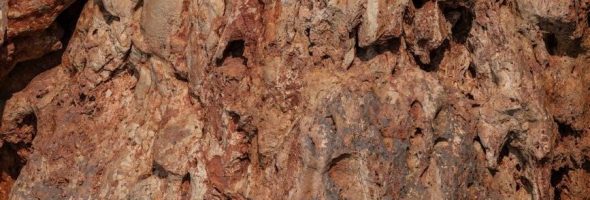Discover the fascinating world of rocks and minerals through this comprehensive guide. Learn essential techniques, tools, and properties to accurately identify specimens using color, luster, hardness, and more.
1.1 Importance of Rock and Mineral Identification
Identifying rocks and minerals is crucial for understanding Earth’s geological processes, history, and resource distribution. It aids in environmental monitoring, locating natural resources, and understanding landscapes. This knowledge is vital for mining, construction, and scientific research, helping us uncover Earth’s secrets and manage its resources sustainably. By identifying specimens, enthusiasts and professionals alike can gain insights into Earth’s formation and evolution, fostering a deeper appreciation for geology and its practical applications in everyday life and industry.
1.2 Brief Overview of Geology
Geology is the scientific study of Earth’s physical structure, composition, and processes. It explores the formation of rocks, minerals, and landforms through plate tectonics, weathering, and erosion. By examining fossils and geological events, geology reveals Earth’s history, including its formation, evolution, and past life forms. Understanding geology helps us locate natural resources, predict natural hazards, and manage the environment. It provides insights into Earth’s dynamic systems, making it essential for both scientific research and practical applications in industries like mining, construction, and environmental management.
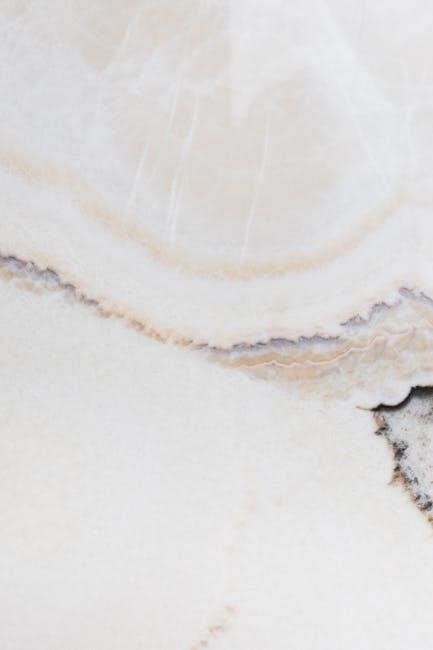
Basic Classification of Rocks and Minerals
Rocks and minerals are classified based on their origin, composition, and properties. Rocks are categorized as igneous, sedimentary, or metamorphic, while minerals are classified by their chemical, physical, and optical characteristics.
2.1 Types of Rocks: Igneous, Sedimentary, and Metamorphic
Rocks are classified into three primary types based on their formation processes. Igneous rocks form from cooled lava or magma, such as granite and basalt. Sedimentary rocks develop from compressed layers of sediments, like sandstone and limestone. Metamorphic rocks emerge when existing rocks transform under intense heat and pressure, resulting in marble or slate. Each type has distinct textures and mineral compositions, aiding in identification. Understanding these categories is fundamental for recognizing and classifying rocks effectively.
2.2 Mineral Classification: Chemical, Physical, and Optical Properties
Minerals are classified based on their chemical composition, physical characteristics, and optical properties. Chemically, minerals are defined by their elemental makeup and crystal structure. Physical properties include hardness, density, and cleavage, which are critical for identification. Optical properties, such as refraction, luster, and pleochroism, are observed under magnification. Tools like streak plates and chemical tests help determine these traits. By analyzing these properties, minerals can be accurately identified and categorized, making classification a foundational skill in geology and mineralogy.

Key Characteristics for Identification
Key characteristics for identifying rocks and minerals include color, streak, luster, hardness, density, crystal habit, cleavage, texture, and grain size. These properties aid in accurate classification and identification.
3.1 Color and Streak
Color and streak are primary characteristics for identifying rocks and minerals. Color is the visible hue, while streak is the color left on a porcelain plate when scraped. While some minerals like malachite have consistent colors, others, such as quartz, vary widely. Streak is more reliable, as it remains consistent regardless of impurities. For example, pyrite has a greenish-black streak despite its golden color. Observing these traits under natural light and using reference guides helps narrow down identifications effectively.
3.2 Luster and Clarity
Luster describes how a mineral reflects light, such as metallic (like pyrite) or glassy (like quartz). Clarity refers to transparency, with minerals being transparent, translucent, or opaque. Observing these properties under light helps identify minerals. For example, quartz is often transparent, while turquoise is opaque. Using a magnifying glass enhances clarity assessment. These traits, combined with color and streak, provide critical clues for accurate mineral identification, aiding in distinguishing similar specimens effectively.
3.3 Hardness and Density
Hardness measures a mineral’s resistance to scratching, ranked on Mohs’ scale from 1 (softest) to 10 (hardest). For example, quartz (7) can scratch glass, while talc (1) is easily scratched. Density reflects a mineral’s mass relative to its volume, helping distinguish similar-looking specimens. By testing hardness with common objects and calculating density, you can narrow down mineral identification. These physical properties, combined with others like luster and streak, provide essential clues for accurate classification and differentiation of minerals. They are fundamental tools in every geologist’s and collector’s toolkit.
3.4 Crystal Habit and Cleavage
Crystal habit refers to the external shape of a mineral’s crystals, such as tabular, prismatic, or needle-like forms. Cleavage describes how a mineral breaks along flat surfaces due to weak bonds. For example, halite exhibits cubic cleavage, while mica shows perfect cleavage in one direction. These properties are crucial for identification, as they reveal a mineral’s internal structure. By observing crystal habit and cleavage patterns, you can distinguish between similar minerals and gain insights into their composition and formation. These characteristics are key in geological studies and specimen analysis.
3.5 Texture and Grain Size
Texture and grain size are vital for identifying rocks and minerals. Texture describes the arrangement of minerals, such as phaneritic (coarse-grained) or aphanitic (fine-grained). Grain size indicates the size of mineral crystals, ranging from microscopic to visible. For example, granite has large, visible grains, while basalt is fine-grained. Sedimentary rocks like sandstone exhibit rounded grains, while shale has microscopic ones. Observing these features helps classify rocks into igneous, sedimentary, or metamorphic categories and provides clues about their formation processes and environmental conditions. These characteristics are essential for accurate identification and understanding geological origins.
Essential Tools and Resources for Identification
Key tools include hand lenses, streak plates, and vinegar for chemical tests. Online databases, field guides, and textbooks provide detailed information for accurate rock and mineral identification.
4.1 Hand Lens and Magnifying Glass
A hand lens or magnifying glass is a crucial tool for examining rocks and minerals. It provides 10x to 20x magnification, allowing detailed observation of textures, grain size, and mineral features. Use it to study crystal habits, cleavage patterns, and small-scale structures that are invisible to the naked eye. This tool is especially useful for identifying minerals with distinctive microscopic features. By focusing light on specific areas, it helps in detecting subtle details like inclusions or color variations, enhancing accuracy in identification. Essential for both beginners and experts, it bridges the gap between naked-eye observation and advanced microscopic analysis.
4.2 Streak Plate and Vinegar
A streak plate is an essential tool for identifying minerals by their streak color, which is the powder left when the mineral is rubbed against the plate. Vinegar is used to test for carbonate minerals, as they react with acid to produce bubbles. The streak plate helps determine a mineral’s true color, often differing from its external appearance. Vinegar identifies carbonates like calcite or limestone. These simple tools provide critical clues for accurate identification, complementing other methods like magnification and observation of physical properties.
4.3 Online Databases and Apps
Online databases and apps are invaluable for rock and mineral identification, offering comprehensive search tools and detailed information. Websites like the Handbook of Mineralogy and Mineralienatlas allow users to filter by properties such as luster, color, and location. Apps like Mineral Identifier provide interactive guides, enabling quick comparisons. These resources often include high-quality images, chemical formulas, and occurrence data, making them essential for both beginners and experts. They complement field guides by offering instant access to a vast database of specimens, enhancing the accuracy of identification processes;
4.4 Field Guides and Textbooks
and Earth Science cover a wide range of topics. These resources often include photographs, illustrations, and chemical formulas, making them essential for both beginners and experts. Many guides are organized by color or properties, simplifying the identification process. They remain vital tools for hands-on learning and fieldwork, complementing digital resources effectively.

Step-by-Step Identification Process
Begin by observing physical properties like color, luster, and hardness. Determine the rock type and use identification charts to narrow down possibilities systematically for accurate results.
5.1 Observing Physical Properties
Start by examining the specimen’s color, luster, and clarity. Note its hardness by testing against a glass plate and determine streak using a porcelain plate.
Observe grain size and texture with a magnifying glass. These physical properties provide foundational clues for identification.
Use guidebooks or online databases to compare observations and narrow down possibilities.
Accurate notes and systematic observation are key to successful identification.
5.2 Determining Rock Type
To determine a rock’s type, first identify its origin: igneous, sedimentary, or metamorphic. Igneous rocks form from cooled magma, often featuring minerals like quartz or feldspar. Sedimentary rocks, such as sandstone or limestone, are composed of compressed sediments. Metamorphic rocks, like marble or slate, result from high-pressure transformations. Examine texture, mineral content, and formation processes. Use guidebooks or online resources to match observations with known rock types. This step narrows possibilities, guiding further identification. Systematic observation and research are essential for accurate classification.
5.3 Using Identification Charts and Flowcharts
Identification charts and flowcharts are invaluable tools for systematically narrowing down rock and mineral possibilities. These visual aids present key questions about physical properties, such as color, luster, hardness, and streak. By answering these questions step-by-step, users can eliminate options and pinpoint likely matches. While flowcharts are often simplified, they provide a clear starting point for beginners. Online databases and field guides further enhance this process, offering detailed comparisons and high-quality images. Combining these resources ensures a more accurate and efficient identification experience, even for complex or unfamiliar specimens.
Common Rocks and Minerals
Explore the diversity of rocks and minerals, from granite to quartz, understanding their unique characteristics, compositions, and roles in shaping Earth’s geology for identification and appreciation.
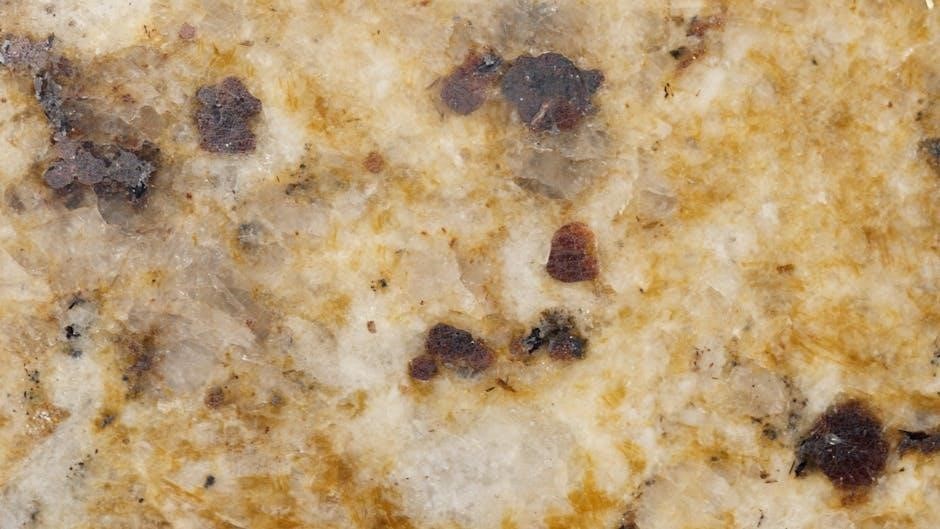
6.1 Igneous Rocks: Granite, Basalt, Obsidian
Igneous rocks form from cooled magma or lava, varying in texture and composition. Granite is coarse-grained with quartz and feldspar, often used in construction. Basalt is dark, fine-grained, and common in volcanic regions. Obsidian, a volcanic glass, exhibits a smooth, glossy texture. These rocks provide insights into Earth’s thermal history and geological processes, aiding in identification through their distinct mineral content and formation environments.
6.2 Sedimentary Rocks: Sandstone, Limestone, Shale

Sedimentary rocks form from compressed layers of sediment, minerals, or organic matter. Sandstone, composed of sand-sized grains, often features quartz and feldspar. Limestone, formed from calcium carbonate, frequently contains fossils. Shale, the finest-grained, is made of clay particles. These rocks reveal Earth’s history through their layered textures and fossil content, offering clues about ancient environments and processes. Their unique compositions and formation conditions make them vital for geological study and identification.
6.3 Metamorphic Rocks: Marble, Slate, Quartzite
Metamorphic rocks form under intense heat and pressure, transforming existing rocks into new textures and minerals. Marble, derived from limestone, features veined patterns and is rich in calcite. Slate, formed from shale, exhibits a smooth, layered texture and is often used in construction. Quartzite, created from sandstone, is durable and primarily composed of quartz crystals. These rocks showcase Earth’s tectonic forces, offering insights into geological history through their unique transformations and mineral compositions.
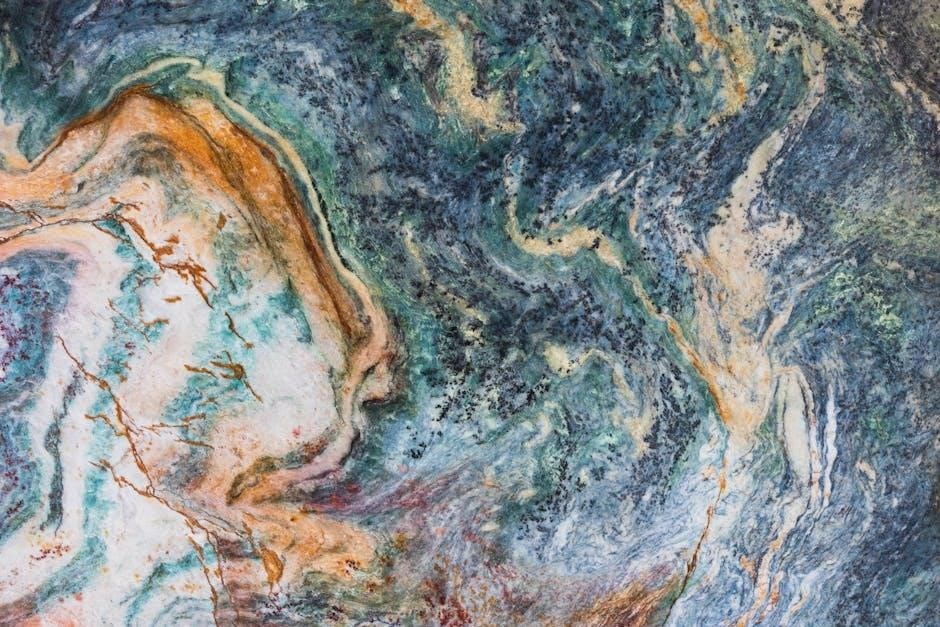
6.4 Common Minerals: Quartz, Feldspar, Mica
Quartz, one of Earth’s most abundant minerals, is known for its clarity and hardness, often found in igneous, sedimentary, and metamorphic rocks. Feldspar, a key component in rock formation, is recognized by its chemical formulas and varied colors. Mica, famous for its shiny, layered appearance, is commonly found in metamorphic rocks and exhibits perfect cleavage. These minerals are fundamental to understanding geological processes and are often used in identification due to their distinct properties and widespread presence in diverse rock types.
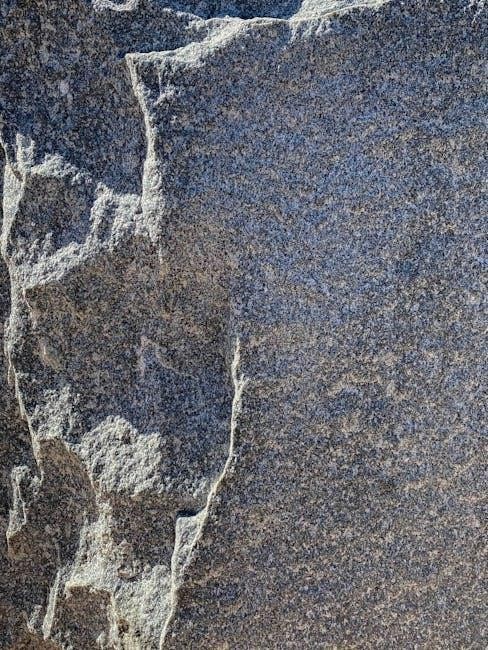
Advanced Identification Techniques
Employ chemical tests, microscopic analysis, and X-Ray Diffraction to precisely identify minerals. These methods reveal detailed crystal structures and compositions, enhancing accuracy in complex specimens.
7.1 Chemical Tests and Reactions
Chemical tests are crucial for identifying minerals, revealing their composition through reactions. Acid tests with vinegar can detect carbonates, while streak plates identify mineral colors. Online databases like the Handbook of Mineralogy and Mineralienatlas provide detailed chemical properties for comparison; These resources, combined with practical tests, enhance accuracy in mineral identification, making them indispensable tools for geologists and enthusiasts alike.
7.2 Microscopic Analysis
Microscopic analysis is a powerful tool for identifying minerals, revealing detailed structures and properties invisible to the naked eye. Using a polarizing microscope, geologists examine crystal habits, grain sizes, and optical properties like birefringence. This method helps distinguish minerals with similar physical characteristics. Online resources, such as the Handbook of Mineralogy, provide reference data for comparison. Microscopic examination is especially useful for identifying minerals in thin sections, making it a cornerstone in advanced geological studies and mineral identification.
7.3 X-Ray Diffraction and Spectroscopy
X-ray diffraction (XRD) and spectroscopy are advanced techniques for identifying minerals by analyzing their crystal structures and chemical compositions. XRD determines the mineral’s crystal lattice arrangement, providing a unique “fingerprint” for identification. Spectroscopy, such as X-ray fluorescence (XRF) or infrared (IR), identifies elemental and molecular properties. These methods are non-destructive and highly precise, making them invaluable for detailed mineral analysis. Online databases, like the Handbook of Mineralogy, offer reference data for comparison, enhancing accuracy in identification. These tools are essential for researchers and professionals in geology and mineralogy.
Embark on a lifelong journey of geological discovery! Use hand lenses, streak plates, and online databases to deepen your skills. Explore textbooks and field guides for continued growth.
8.1 Encouragement for Continuous Exploration
Embrace the thrill of discovery and continue exploring the fascinating world of rocks and minerals. Each specimen holds a unique story, offering insights into Earth’s history. With tools like hand lenses, streak plates, and online databases, you can deepen your knowledge. Practice regularly, as every observation sharpens your skills. Join geology communities, attend workshops, and venture into the field to uncover new treasures. Remember, every rock and mineral is a puzzle waiting to be solved, making this journey endlessly rewarding and enriching.

